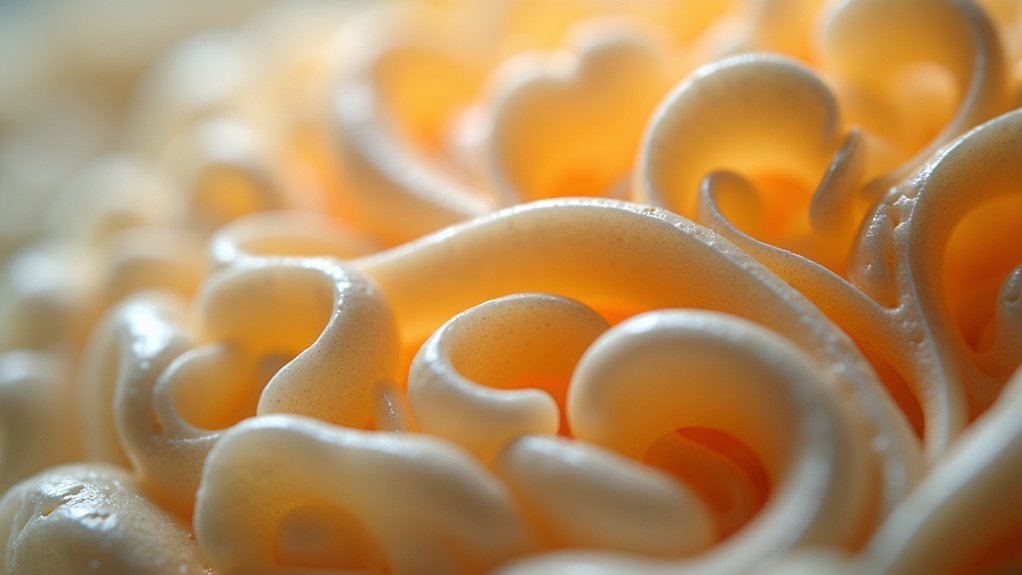You can carve hollow wax designs using three proven methods: the bisecting technique where you cut the bead in half with a jeweler’s saw and hollow each section with ball burs, the core removal approach that uses strategic drainage holes for investment flow-out during casting, and the two-part assembly method that breaks complex forms into manageable components. Each technique maintains 2mm wall thickness while preventing structural collapse. Master these approaches and you’ll reveal advanced hollow casting possibilities.
Bisecting and Hollowing Method

When creating hollow wax designs, you’ll begin by carefully bisecting your bead with a 2/0 jeweler’s saw blade, which allows for precise hollowing and proper realignment once you’ve completed the shaping process.
This bisecting technique guarantees you can access the interior effectively while maintaining control over your design.
Use ball burs to remove interior material evenly, maintaining approximately 2mm wall thickness throughout.
This consistent measurement preserves structural integrity and prevents collapse during the casting process. Remove material gradually to avoid excessive thinning that could compromise your piece’s strength.
After hollowing both halves, employ a wax pen to weld them together, creating a seamless finish.
Consider incorporating drainage holes to facilitate investment flow and eliminate trapped air, guaranteeing successful casting results.
Core Removal Technique
After casting your hollow wax design, you’ll need to remove the core material and any trapped investment to achieve a clean, functional piece.
The core removal technique begins with utilizing those ventilation holes and drainage holes you created during wax carving. These openings allow investment material to flow out naturally during the casting process.
For thorough post-casting cleanup, employ ultrasonic cleaning with appropriate solutions to eliminate stubborn investment from hollow cores. This method effectively reaches areas that manual cleaning can’t access within your hollow forms.
You must completely remove all investment material before any soldering work, as residual investment can turn to steam under heat, causing dangerous pressure buildup that could make your piece explode.
Proper core removal guarantees your hollow wax design functions safely.
Two-Part Assembly Approach

Since hollow wax designs can present significant challenges during carving and assembly, the two-part assembly approach offers a practical solution that breaks down complex forms into manageable components.
You’ll find this method allows you to carve each half separately, ensuring greater precision while reducing the risk of damaging intricate details. This approach enables you to incorporate internal support structures that prevent wall collapse during casting.
When you’re ready to join the pieces, you can easily weld the halves together using a wax pen, creating a seamless connection between components.
This technique helps jewelers manage the complexities typically associated with hollow casting, transforming what’s traditionally challenging work into a more approachable and controlled process.
Frequently Asked Questions
What Are the Different Types of Wax Carving?
You’ll find green wax offers sharp edges, purple wax provides general-purpose flexibility, and blue wax delivers maximum flexibility for detailed work. Wolf Relief Wax helps you attach pieces and create forms during carving.
What to Use to Carve Wax?
You’ll need green wax for sharp details, purple for flexibility, wax saws, files, and dental scrapers. Consider a Foredom Wax Carver with variable heat settings for serious projects requiring controlled melting and precise shaping.
What Is the Lost Wax Carving Method?
You’ll create a wax model, encase it in hardened mold material, then melt away the wax. You pour molten metal into the empty cavity, creating intricate metal pieces impossible with traditional metalworking.
Is Wax Carving Difficult?
You’ll find wax carving challenging initially since it demands precision, steady hands, and patience. However, with practice using proper tools like jeweler’s saws and wax files, you’ll develop the technical skills needed.
In Summary
You’ve now learned three effective methods for creating hollow wax designs. Whether you’re using the bisecting technique, removing cores, or assembling two parts, you’ll achieve professional results with practice. Don’t be discouraged if your first attempts aren’t perfect – each method requires different skills and timing. Start with simpler designs and gradually work toward more complex shapes. With these techniques mastered, you’ll create stunning hollow wax pieces for any project.





Leave a Reply